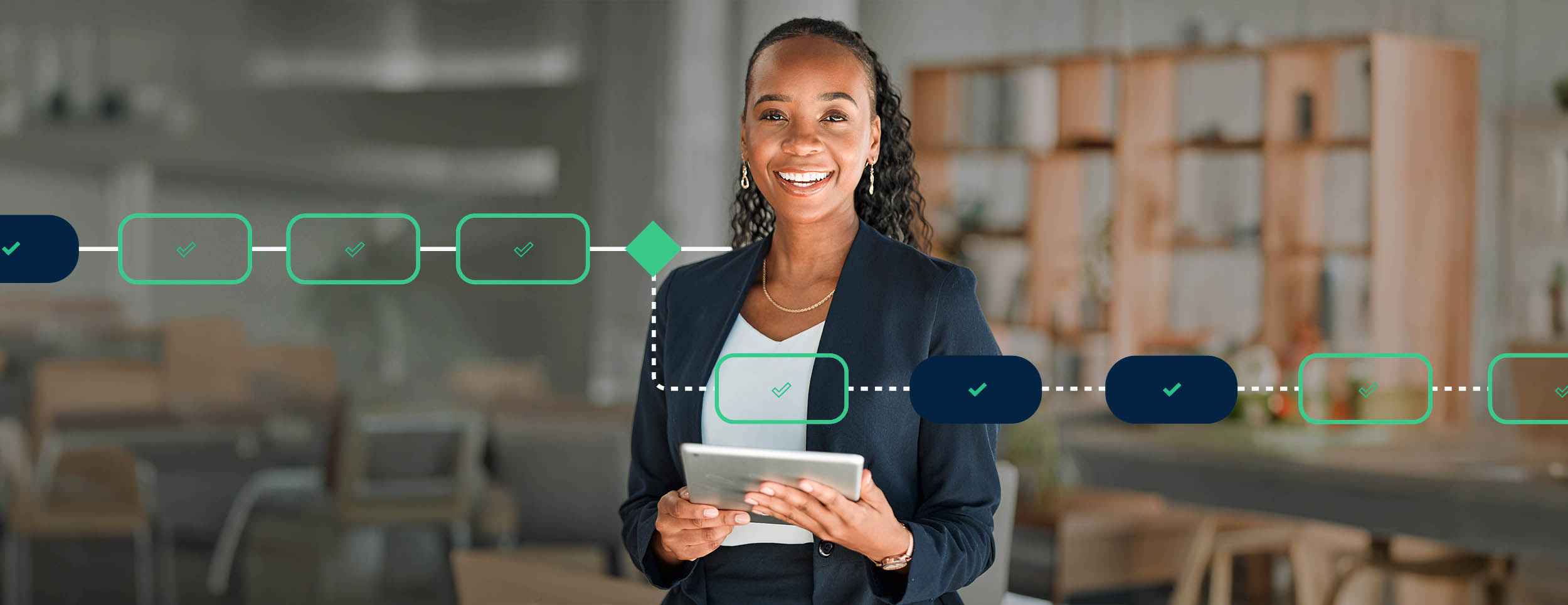Finding the right process automation tool for IT
IT process automation tools include a wide range of apps and technologies that support end-to-end process orchestration.

If your IT team is swamped with manual tasks like transferring data between systems, scheduling batch jobs or troubleshooting issues, they’re spending little time innovating. You’re not making the most of your investment in great people, and they’re not enjoying the opportunity to be creative and contribute to strategic project management.
In this type of environment, miscommunication and inconsistency are rampant. It can feel like greater efficiency isn’t possible. That’s because it isn’t with your current tools.
However, there’s hope. With a process automation tool, your IT department can reclaim their time and support broader business goals. Using drag-and-drop interfaces and pre-built templates, your team members can engage in task management and workflow management with confidence.
Read on to understand how enabling complex workflow orchestration, real-time monitoring, alerting and more can transform how you work.
What are process automation tools and how do they work?
Process automation tools enable users to automate manual processes and tasks, often through a user-friendly workflow designer that supports low-code development. This allows users to build and automate processes without the need for custom scripting.
These tools make it easier to manage the complete process lifecycle by providing monitoring, alerting, resource management and advanced DevOps capabilities. They help you identify and eliminate bottlenecks and improve your overall responsiveness to changing business needs.
Platforms with robust connectors enable you to see all critical updates in one place. Dashboards could enhance visibility over data routing and mission-critical processes such as procurement.
Features of process automation tools
Let’s take a look at four categories of process automation platforms and the typical features and automation capabilities of each.
- IT process automation (ITPA) tools
- Business process automation (BPA) tools
- Robotic process automation (RPA) tools
- Digital process automation (DPA) tools
There is plenty of overlap in capabilities between these categories, but it’s important to note that they do not share the same origin and, hence, do have different capabilities.
IT process automation (ITPA) tools
IT process automation solutions emerged from batch scheduling technologies first developed in the 1960s. These tools evolved into job schedulers that provided event automation as well as date/time scheduling.
Today, ITPA tools provide visual workflow designers and API accessibility, enabling IT to construct processes that manage data and dependencies across disparate systems and technologies.
Because ITPA platforms are designed to be used by IT in support of an organization’s digital infrastructure, they make it possible to orchestrate processes across the enterprise. ITPA capabilities can (and should) include:
- Advanced analytics, in-depth views and automated logging to minimize the time it takes to troubleshoot and optimize processes
- Dynamic resource provisioning to ensure processes have adequate compute to successfully complete
- Event-based automation to trigger processes based on IT and business events
- Real-time monitoring and notifications to keep IT up to date and support auto-remediation for unexpected issues or complications
Business process automation (BPA) tools
Business process automation came about in the early 2000s as a consequence of business process management (BPM) technology.
BPM dates back to the 1980s and ‘90s. Organizations were digitizing tasks and processes and driving the need to standardize and optimize those processes. As the volume of digital processes grew, so did the need to automate.
Business process automation tools go beyond day-to-day task management and provide tools to develop, automate and monitor complex processes critical to business operations. This can include pulling data from multiple systems to automate employee onboarding processes, trigger file transfers based on business events and compile and distribute reports to employees or customers.
Robotic process automation (RPA) tools
Similar to BPM, robotic process automation tools evolved from back-office screen-scraping technologies that were popular in the 1980s and ’90s. This is what sets RPA tools apart from other process automation tools — RPA largely operates via the user interface, whereas BPA and ITPA interact with other applications at a deeper programmatic level.
RPA software automates rule-based, repetitive tasks such as data collection, data entry or creating user accounts. For example, if a customer has applied for an insurance quote, an RPA bot can collect that information and enter it into a desktop application or Excel spreadsheet.
Interest in RPA solutions has surged in recent years as an effective way to provide desktop automation for office employees. However, RPA implementations have been limited by the rigidity of the scripts that underlie these processes, as well as the impact large deployments of software robots can have when IT isn’t positioned as an owner.
Digital process automation (DPA) tools
DPA is a hybrid of ITPA and BPA. It streamlines and optimizes the end-to-end delivery of data to support the customer experience.
For instance, when online traffic surges for a retailer, a DPA tool can provision the servers needed to support the extra traffic. A parallel DPA process can then take the customers’ information, perform an ETL process and send the data to a BI tool before sending a morning report to the appropriate business users.
What are the benefits of using a process automation tool?
Process automation tools offer a wide range of benefits that can transform how businesses operate. By eliminating repetitive manual tasks, these tools allow teams to focus on more strategic priorities, streamline operations and scale efficiently. Let’s break down the core benefits into a few key areas.
Increased accuracy and reduced errors
One of the most immediate benefits of automation is the dramatic reduction in human error. When tasks like data entry or invoice processing are handled manually, mistakes can creep in — even with the most careful employees. Automation tools execute processes based on predefined rules, ensuring precision every time. For industries like finance, healthcare and logistics, this level of accuracy is critical. The result? Fewer mistakes, improved compliance and smoother workflows.
Scalability to support business growth
As businesses grow, manual processes often become a bottleneck. Tasks that worked fine at a small scale can quickly overwhelm teams as the organization expands. Automation tools provide the scalability needed to handle increasing workloads without sacrificing efficiency. Whether managing hundreds or thousands of workflows, automation ensures processes run consistently, no matter the volume. This scalability positions businesses to adapt and thrive in dynamic markets.
Cost savings and operational efficiency
Automation tools don’t just save time — they save money. By reducing manual labor, improving turnaround times and cutting down on errors, businesses can significantly lower their operating costs. While there may be an initial investment in adopting automation, the long-term savings often outweigh this cost. For example, automating a single high-volume task, such as payroll processing or order fulfillment, can yield measurable savings in labor and overhead.
Enhanced visibility and control
With automation tools, visibility into your operations improves dramatically. Most platforms include dashboards and analytics that provide real-time insights into workflows, helping managers monitor progress, identify bottlenecks and optimize processes. This visibility also supports regulatory compliance by maintaining detailed logs and records. Whether preparing for an audit or analyzing performance trends, automation tools make it easy to stay in control.
Top 10 process automation tools
- ActiveBatch by Redwood
- RunMyJobs by Redwood
- Appian
- Automation Anywhere
- Bizagi
- Blue Prism
- Nintex
- ServiceNow
- Tungsten TotalAgility
- UiPath
1. ActiveBatch by Redwood
ActiveBatch is the easiest-to-use workload automation platform in the marketplace for automating both IT and business processes.
Key features
- Date/time- and interval-based scheduling across timezones
- Health Service for monitoring system performance
- Integrated job steps library for simple job creation and management
- Machine resource optimization
Web Services API and Service Library supporting both SOAP and REST
Ready to see how we make workload automation easy? Schedule a demo to see how easy it is to build and maintain your jobs in ActiveBatch.
2. RunMyJobs by Redwood
RunMyJobs is the full stack advanced workload automation platform and SAP’s #1 job scheduler for building end-to-end business and IT processes.
Key features
- A catalog of easy-to-install connectors
- Date/time- and event-driven job scheduling
- Seamless integration of apps across on-premises, hybrid and cloud environments
- Support for over 25 scripting languages
- The first native SaaS job scheduler
Visit redwood.com to learn more.
3. Appian
Appian is a low-code automation platform and data fabric solution that accelerates the creation of high-impact business applications.
Key features
- AI-powered automation to eliminate time-consuming tasks
- Built-in development governance
- Process intelligence for pinpointing inefficiencies
- Real-time process performance tracking
- RPA, AI, IDP and API integrations
Learn more at appian.com.
4. Automation Anywhere
Automation Anywhere is a powerful, user-friendly platform that supports both attended and unattended bots.
Key features
- Accessible to non-technical users for easy scalability
- Automations for order-to-cash, procure-to-pay and other common business processes
- Cognitive automation with AI capabilities
- User-friendly bot creation for repetitive tasks
- Visual editor and pre-built templates for automation building
Visit automationanywhere.com for more information.
5. Bizagi
Bizagi is a business process automation software with a low-code interface and built-in artificial intelligence.
Key features
- AI tools for parsing, extracting and analyzing unstructured text
- Cloud and on-premises deployment options
- Drag-and-drop visual process modeling
- Role-based user experiences
- SLA escalation and audits
Visit bizagi.com to learn more.
6. Blue Prism
Blue Prism is a robust, secure, and scalable RPA platform ideal for enterprises that need to deploy large numbers of robots.
Key features
- Automation lifecycle management toolkit
- Decision automation with detailed audit logs
- Integrated process intelligence for rapid process flow analysis
- Process assessment tool for validating and scaling RPA
- Task and process mining for automation optimization
Learn more at blueprism.com.
7. Nintex
Nintex is a workflow automation software designed to automate complex business processes quickly and easily.
Key features
- Integrated forms automation, RPA, document generation and e-signature
- Mobile workflow management apps
- Process identification and task-level process mapping
- System health insights and BI integrations
- User-friendly interface with customizable branding
Visit nintex.com for more.
8. ServiceNow
ServiceNow is a cloud-based platform for digital workflow automation and enhancing operational efficiency for IT services.
Key features
- Certificate inventory for tracking TLS certificates
- Customizable service portal
- Integration with ITSM and ITOM
- Real-time data analytics and reporting dashboards
- Service Graph Connectors for integrating external data
Learn more at servicenow.com.
9. Tungsten TotalAgility
Tungsten TotalAgility is a flexible low-code process orchestration platform with intelligent document processing.
Key features
- Automations for improving the employee and customer experience
- Case management tools for better decision-making
- Document library with pre-trained extraction models
- Generative AI for conversational insights
- Workflow optimization and dynamic rules management
Discover more about Tungsten TotalAgility.;
10. UiPath
UiPath is a well-known RPA platform that allows businesses to start small and scale quickly.
Key features
- Automation for UI elements and APIs
- Enterprise-grade orchestration tools
- Extensive library of pre-built activities
- Intuitive automation design tools
- Task, process and communications mining
Visit uipath.com for more information.
Digital transformation and process orchestration in 2025
IT organizations are managing more data, applications and systems than ever before, with environments that are increasingly diverse, leveraging open-source tools, SaaS, cloud-based infrastructure, on-premises mainframes, etc.
New tools and technologies — AI, IoT, 5G, natural language processing — are opening new possibilities for the digital workforces willing to adopt them, and the market pressures to adapt to these changes are increasing. To stay ahead, organizations need the capacity to rapidly integrate new tools with existing legacy systems and create processes that leverage these new technologies.
This requires process orchestration, an emerging field occupied by a variety of technologies applied to a range of use cases. Automation providers have, in some cases, successfully developed products that provide the tools needed to integrate, automate, optimize and orchestrate disparate processes into end-to-end processes.
Process orchestration tools sometimes incorporate intelligent automation to help manage the entire process lifecycle using workflow automation, machine learning and advanced analytics to manage and optimize those processes.
Current orchestration technologies include workload automation (WLA) tools, service orchestration and automation platforms (SOAPs) and enterprise cross-platform job schedulers.
The right process orchestration tool can provide the extensibility to rapidly integrate any new tool or technology, with DevOps tools that accelerate process creation and iteration and keep IT in control yet collaborative.Redwood Software was named a Leader in the 2024 Gartner® Magic Quadrant™ for SOAPs report, positioned furthest in Completeness of Vision. ActiveBatch by Redwood is part of Redwood’s suite of automation fabric solutions. Book a demo to find out more.
Process automation FAQs
Process automation refers to the use of technology to perform repetitive tasks or processes in a business or organization. With software applications, systems and various technologies, process automation streamlines operations, reduces manual intervention and improves efficiency. Organizations can apply process automation to achieve greater accuracy, consistency and speed in both IT and business processes. Process automation can be applied to a wide range of activities, from simple tasks like data entry and report generation to complex business workflows that involve multiple departments and systems.
In addition to enhancing efficiency, process automation minimizes errors. It ensures that tasks are completed on time and according to predefined standards, which improves overall quality and reliability. Moreover, process automation can provide better visibility and control over business operations through real-time monitoring and reporting, enabling managers to make informed decisions. This transformative approach is crucial for businesses seeking to remain competitive in a fast-paced, technology-driven market.
Learn more about process automation tools and help enable users to automate manual processes and tasks.
SAP process automation means using leading technology company SAP’s software and tools to automate business processes within an organization. SAP is a leader in enterprise resource planning (ERP) solutions and offers various automation tools that integrate seamlessly with its suite of products. These tools help businesses automate routine tasks, streamline workflows and enhance operational efficiency. SAP process automation leverages technologies such as RPA, machine learning, artificial intelligence and advanced analytics to optimize processes across different departments.
By implementing SAP process automation, organizations can significantly reduce manual effort and human error to generate more reliable business outcomes. For example, SAP Intelligent RPA (SAP IRPA) automates repetitive tasks like invoice processing, data entry and customer service interactions. SAP’s automation tools can integrate with existing SAP systems to build a unified platform for managing business operations. This integration capability facilitates better data consistency and improves compliance.
Learn more about enterprise automation for SAP processes.
An example of business process automation is the automation of the accounts payable process within an organization. Traditionally, this process involves multiple manual steps, including receiving invoices, matching them with purchase orders, obtaining approvals and processing payments. Software solutions can streamline and expedite these tasks. Automated systems receive and validate invoices electronically, match them with purchase orders and delivery receipts, route them for approval and even trigger payment disbursements without human intervention.
Discover how to automate routine tasks, develop innovative processes and upgrade business and IT operations with ActiveBatch.
Workflow automation is important because it enhances the efficiency and effectiveness of business operations by reducing the need for manual intervention in routine tasks. By automating workflows, teams complete tasks faster and with fewer errors for greater productivity and efficiency. Automation helps to standardize processes, which supports high-quality output and compliance with regulatory requirements.
Workflow automation also provides better visibility and control over business processes. Automated systems can track the progress of tasks in real time, provide insights and alert stakeholders to any issues or delays. Enhanced transparency enables managers to make data-driven decisions, optimize resource allocation and improve overall process management. Workflow automation tools also free up employees to focus on more strategic and value-added activities, fostering innovation and driving business growth. Automation is a proven tool for reducing costs and remaining competitive in a rapidly evolving business environment.
Discover how to build and automate reliable end-to-end workflows in half the time with advanced workflow development and management capabilities.







